Amazon Mobile vs. Desktop: Differences in Product Visibility


Do you know how your products show up on the Amazon mobile site vs. your desktop?
Even if you don’t, your customers do, and it could affect their purchasing decisions.
Today, we’re going to investigate the way a single search performs across three Amazon platforms: mobile, desktop, and the basic Amazon Shopping app.
General ecommerce data provided by Custora shows mobile purchases jumped from 25% in 2015 to 29% early this year. On Amazon, the preference for mobile is even more pronounced. In Q4 2015, a jaw-dropping 70% of Amazon customers purchased items on mobile devices. Let’s dive into what makes mobile different than other platforms.
Note: Keep in mind we’re analyzing the mobile site via the Chrome browser, and these numbers reflect purchases made in-app as well. (We’ll examine Amazon app later in this post.)
It’s finally summer, and we’re excited to spend some time by the pool. So we’re going to search for—what else—the perfect “giant pool float” on the Amazon mobile site.
Our search begins.
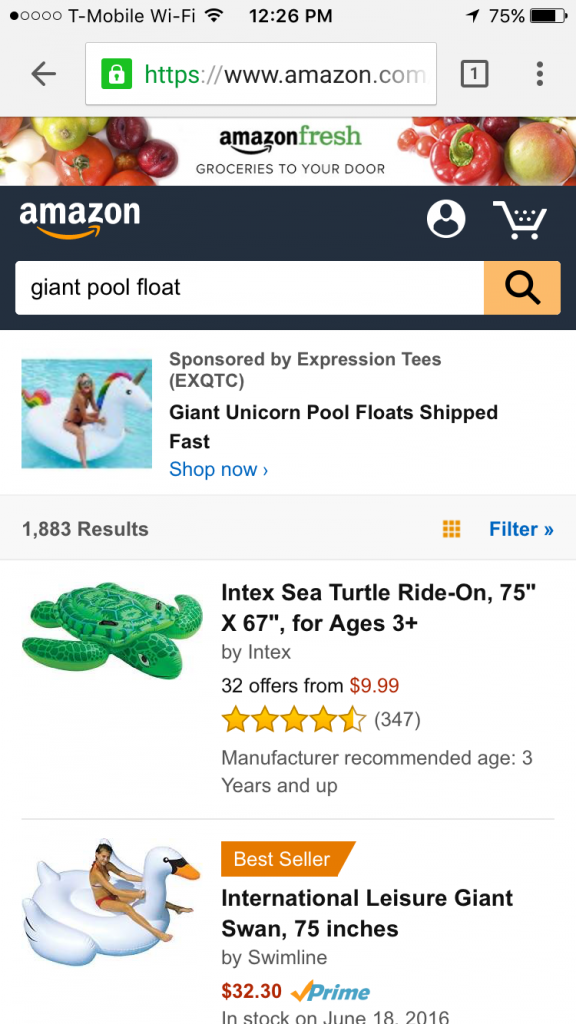
Amazon Mobile Site Product Search
First, let’s take a look at the ads. Marketplace Channel Analyst David Cooley of CPC Strategy points out one key difference between ads on  Amazon mobile vs. desktop.
Amazon mobile vs. desktop.
“On a mobile experience, all the Sponsored Product ads are baked into the results, so it’s tougher for the customer to identify which is the ad and which is not.”
Other than the Amazon Fresh promo, you’ll see the first Sponsored ad by a seller is a Giant Unicorn Pool Float. The seller has made the most of this slim ad by including “Shipped Fast” to the end of the headline.
1,883 results are up, and the filter option is obviously located on the right to make it easy for buyers to narrow down their search.
The turtle might be cheaper, but we’re set on the pool float Taylor Swift immortalized—the giant swan. We can see it’s a Prime product, and the size, 75 inches, confirms that the size is giant.
Additionally, we can see it’s a Best Seller, which reassures us this product is in demand. Let’s move forward with the “International Leisure Giant Swan”. Next, we’ll hit the Product Detail page.
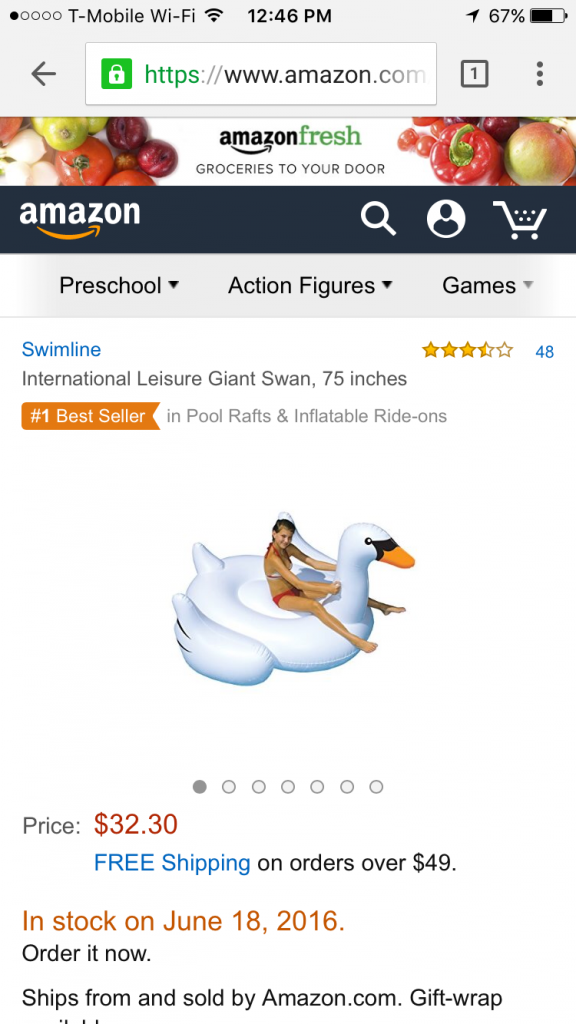
Amazon Mobile Site Product Detail (1)
First, notice the lack of ads (aside from Amazon Fresh) that appear above the fold on the mobile site product page. The seller’s product dominates the page.
Additional options above include “Preschool”, “Action Figures”, and “Games”. These aren’t exactly conducive to our current search, but we can see Amazon’s trying to gauge our interests, likely based on purchase decisions by other giant swan buyers.
The reviews look pretty solid, and there are plenty of photos to scroll through in case we want to see other sides of our swan. As we scroll down more, we’ll find one of the biggest reasons sellers benefit from mobile purchases—fast customer access to the coveted Amazon Buy Box. Not only is it above other product suggestions and even the product description and features, it also means that the seller in the Buy Box is virtually guaranteed that sale.
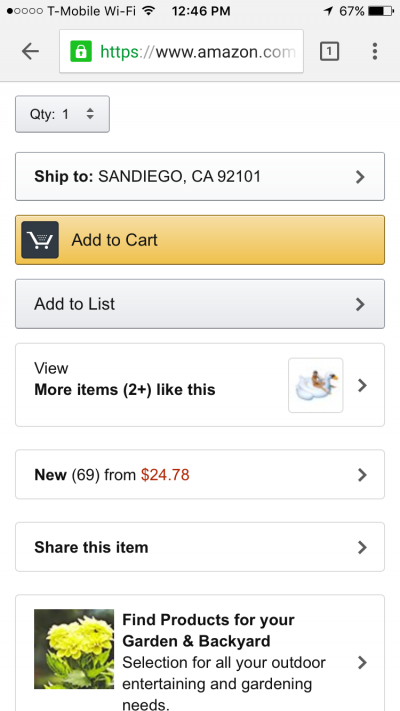
Amazon Mobile Site Product Detail Page (2)
If we scroll down more, we’ll see other similar products, grouped together:
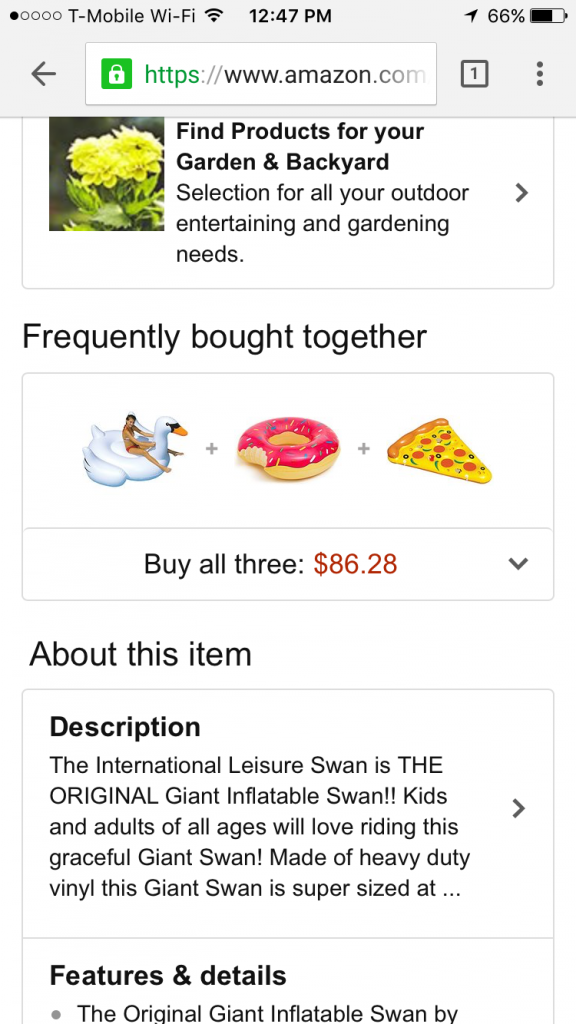
Amazon Mobile Site Product Detail Page (3)
Now, we have the option to buy all three. Tempting, but we’ll keep on moving since we really only need a swan. Note the distance we had to travel to see the Description and Features. One interesting thing to note is that descriptions show up first on mobile, before bullet points. Don’t forget to optimize that description!
If we want to see other types of giant floats, we’ll have to go back to the original search. The design isn’t exactly ideal for “shopping around”. [bctt tweet=”Amazon mobile is optimal for quick purchases that don’t require buyers to”shop around”.” username=”slylikeasmeagol”]
Although the majority of Amazon shoppers buy on mobile—and number of mobile buyers are rising at a rapid rate—the majority of all ecommerce conversions are still made on desktop, according to data from the Custora Ecommerce Pulse report for 2016.
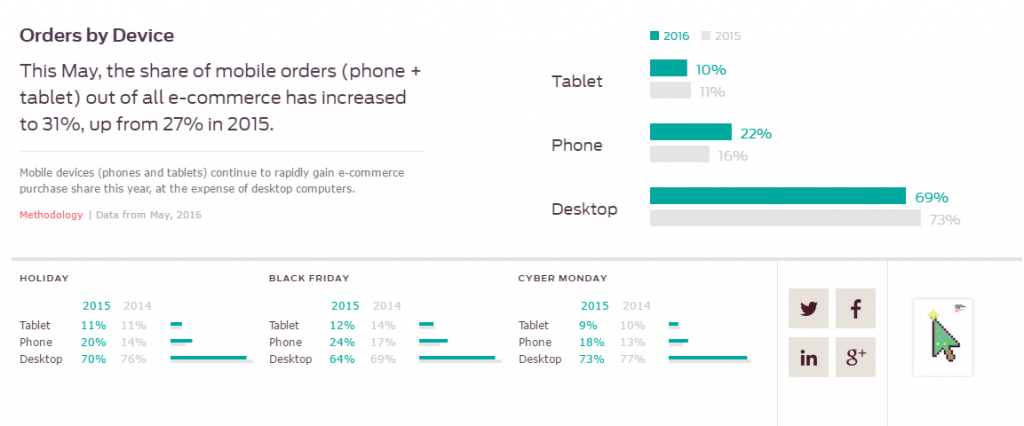
Custora Ecommerce Pulse Report A1 2016
We reviewed the Amazon buyer experience for the same search on incognito mode on a Chrome desktop browser. Check out the results below:
Amazon Desktop Product Search
Of course, on the desktop browser, we can refine our search by brand, department, and Prime eligible products on the left column. Unlike the mobile site experience, which only offers filters on a second click, you can see all of your options—from pool floats to grown-up toys—at a glance.
Let’s talk Amazon desktop ads. “Advertisements in general stick out a little bit more in desktop—they’re a little bit easier to identify,” Cooley says.
The key words here? “A little bit easier.” The light gray “Sponsored” mark above the Pfloat Giant Inflatable Unicorn doesn’t stand out too much. Buyers might easily mistake this for an organic listing if they’re not paying attention.
Anything else different than the Amazon mobile search experience for a “giant pool float”?
The swan doesn’t show up at the top, even though we conducted both searches within a short period of time on both. If you’ve been selling on Amazon long enough, you know that your product rankings can vary at any given moment. If we started our search on a desktop in the same frame of mind, we may have considered settling on the Intex Sea Turtle instead. However, let’s say (for the sake of continuity), that we noticed the swan in the “Shop by Category” section, and decided to click through to “Pool Rafts & Inflatable Ride-ons”. Let’s study the Product Detail page.
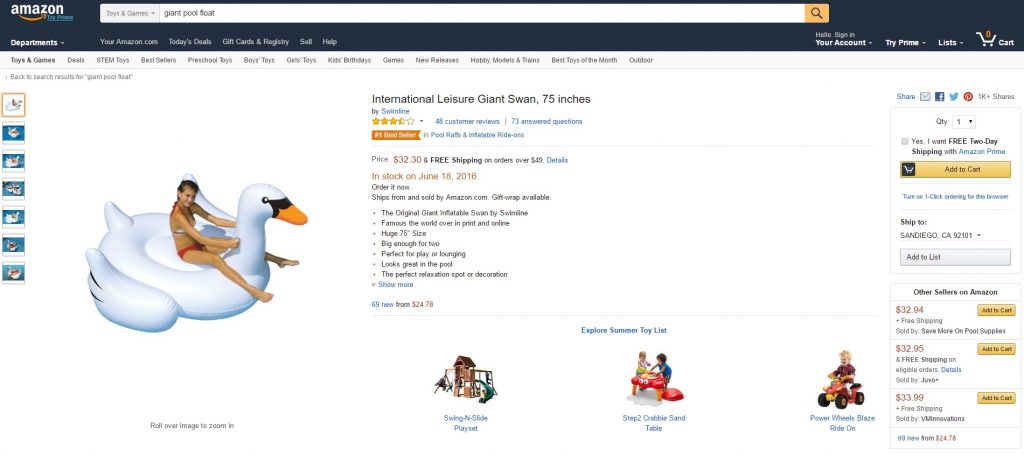
Amazon Desktop Product Detail Page
Notice how the same product listing as the mobile site appears on desktop. We still have the option to roll through various photos, with the added benefit of rolling over the image to zoom in on the main photo. One of the biggest advantages the desktop version offers is bullet-pointed information above the fold.
It’s important to make sure those bullet points are optimized to showcase what your buyer cares about most. Do they want to know their pool float is famous? That it’s “big enough for two”? (There are several bullets that don’t seem important here, such as “the perfect relaxation spot,” but we get it—there isn’t much more to expand on when you’re talking about an Inflatable Swan.)
The same “summer toys” show up below as those on our Amazon mobile site search, but again, we’re not really interested in those right now, and they’re really not related to directly to competing products. On the right side, you’ll notice “Other Sellers on Amazon”—additional competition for buyer attention that wasn’t as prevalent on our mobile search.
So far, we can see desktop offers everything up at-a-glance, which is useful for purchasers who want to get a little more information up front before buying. However, there’s more competition for sellers, especially on the product page. Overall, the desktop buyer experience is more conducive to the “shopping around” and research phases of a purchase.
At CPC Strategy, we’re focused on mobile strategy, and the Amazon App in particular. As Cooley points out,“The app user interface is a lot easier to use”. By the way, if you want to dive deeper, check out our blog post overview on Amazon mobile apps.
Are you tired of giant pool floats yet? Hang on—we’re moving to the most popular shopping apps out there—the basic Amazon Shopping app.
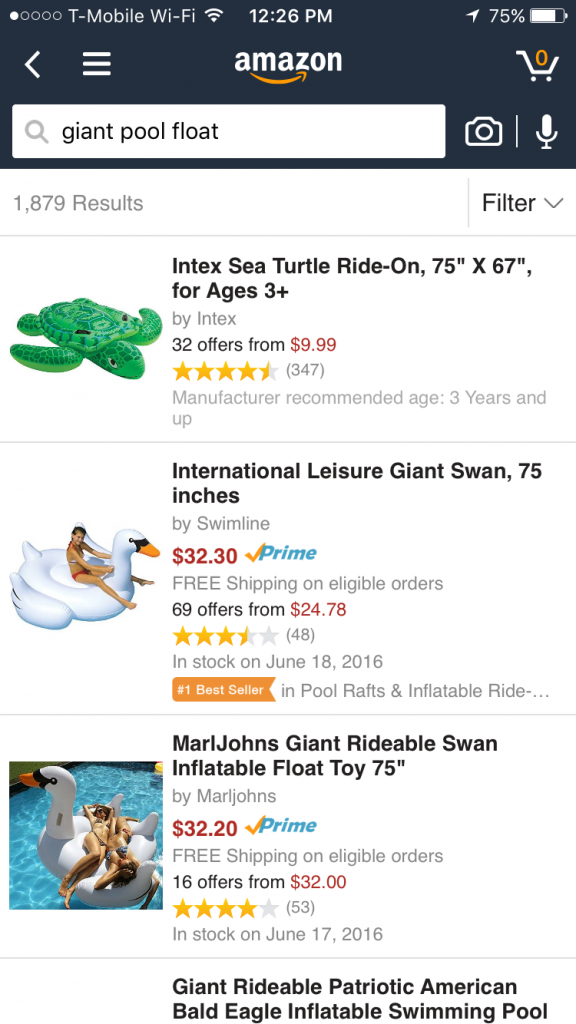
Amazon App Product Search
The first thing you might notice—apart from that same turtle—is the appearance of a rival swan above the fold. The MarlJohns Giant Rideable Swan Inflatable Float Toy, to be exact. This competing swan is the same size as our original pick, at 72 inches, but there are a few other key differences in the listing that might make potential buyers think twice about buying the International Leisure Giant Swan.
While our original International Leisure Giant Swan features a photo of a swan on a plain white background, the MarlJohns swan is shown on a bright blue pool with two swan “riders”, suggesting greater capacity. It’s also Prime eligible, 10 cents cheaper, and is in stock a full day sooner than our original pick.
What don’t they have? The #1 Best Seller banner. It’s a negligible difference, but it’s important to note because that competitor swan could be the #1 Best Seller in a few days. For the purposes of our research, we’ve decided the banner gives us just enough reassurance that the International Leisure Giant Swan is the right swan for us. On to the Product Detail page!
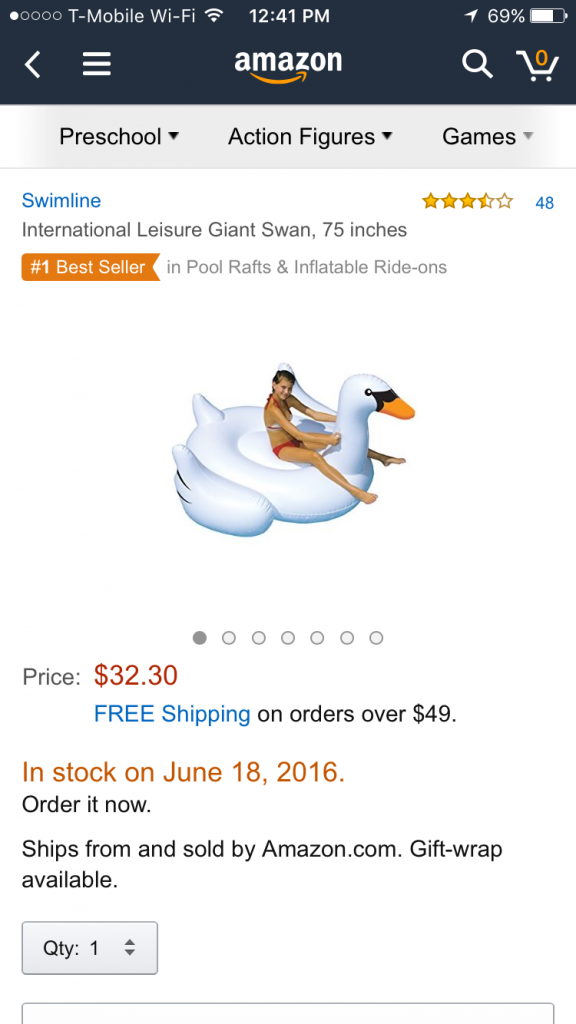
Amazon App Product Detail Page (1)
Feeling a bit of deja-vu? This app Product Listing page is a dead ringer for the Amazon mobile site Product Listing (aside from that Amazon Fresh promo). Here it is again for reference:

Next up, we see that a “Summer Toy List” pops up before other similar products:
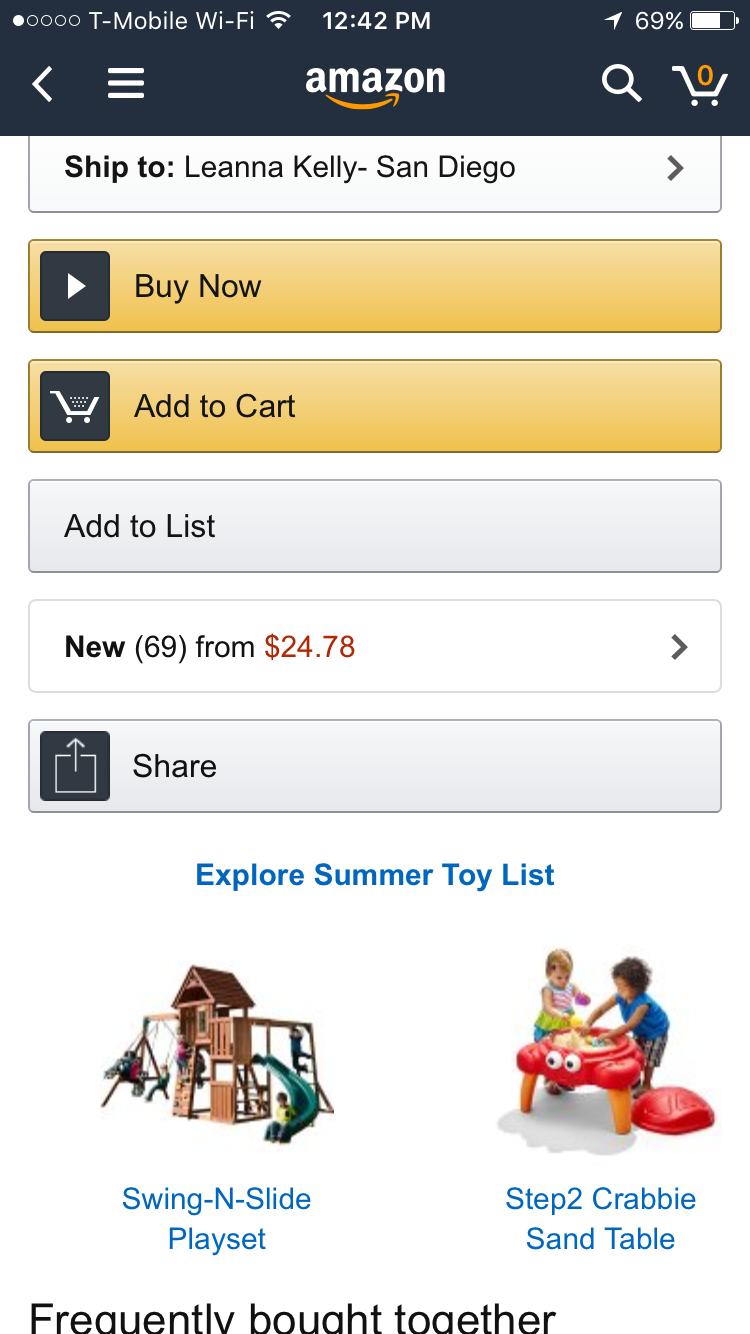
Amazon App Product Detail (2)
Since we’re not interested in purchasing a playset at the moment, we will either continue with our purchase options: “Buy Now” or “Add to Cart”, or scroll down even further.
We’ll save you the trouble of scrolling through the rest of the images—the results are the same all the way down across mobile search and in-app. Both bullet points and descriptions are far below the fold, as expected on Amazon mobile.
Unfortunately, there are still very few reporting options on Amazon. The most important metrics on your account are still Sales Volume and Advertising Cost of Sale (ACOS) as a percentage.
“Say you want a 50% ACOS, so every dollar you spend, you want two dollars of return…[if you get above that percentage], you should down bid,” Cooley says.
Right now, sellers don’t have a lot of control how products rank or appear across all platforms at any given point. Instead, focus on optimizing Amazon content.
“Sellers should focus on how the listings are displayed on desktop and mobile and how content is featured on both”, says Cooley.
Review your:
Wondering where to start? Check out our post covering the best Amazon content optimization practices, and start selling better across all platforms.
